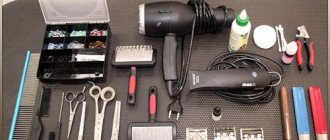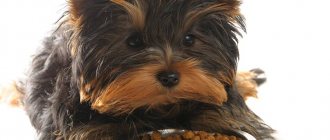Purebred Yorkshire terriers that meet the official breed standard have small, triangular, erect ears; however, some Yorkies cannot boast of standing ears on their own. This may be due to a number of reasons and makes it impossible for the dog to participate in exhibitions. But you shouldn’t give up ahead of time - there are several ways to fix your pet’s ears.
When do they start getting up?
At birth, Yorkshire Terriers have small, floppy ears. Over time, they grow, the ear cartilage becomes stronger and the ears stand up. Naturally, they will rise between the ages of 1 and 4 months, however, all puppies are individual and the timing varies. At this time, the skeleton and cartilage are actively growing, and teeth are changing, which determines the puppies’ need for calcium.
As a rule, the ears finally stand up after a complete change of teeth and the fact that before that they are in a hanging or semi-hanging position is normal. However, many Yorkie owners still use one of the methods of ear placement as a preventive measure; this does not harm the pet’s health.
When do Yorkies' ears stand up?
A dog is a living creature, so it is impossible to predict with an accuracy of a day or even a week when a Yorkie’s ears will stand up. Sometimes this happens as early as 2 months, sometimes much later. Don’t worry if your neighbor’s puppy of the same age already has strong “locators” sticking up, and your pet has some rags hanging from it. Perhaps they are growing up differently and very soon their ears will rise.
Cause for alarm should appear when the Yorkie is 4 months old, and the ears remain in a hanging position. Some dog lovers believe a sign: when the teeth are changed, the ears should rise. Look at your pet's mouth; if his incisors and fangs are rapidly growing, it means that soon his ears will stick up. This rule can only be applied if baby teeth fall out early, as in some dogs this happens closer to one year. In any case, 4 months is the deadline, after which you need to find out the reason for the delay. If you can't figure it out on your own, contact your veterinarian.
Sometimes a Yorkie puppy's ears stand up, and after a while they fall down again. This usually happens when the puppy’s teeth have not yet changed. The growth of adult incisors and canines requires a lot of calcium and other essential substances. The body devotes all its resources to teeth growth, the ears weaken and droop. This is a temporary phenomenon and there is no reason to worry. If the ears have already risen, it means that there are no pathologies in the cartilage and muscles; now you just need to make sure that the delicate tissues are not damaged. Soon the body will get stronger and everything will return to normal.
Causes of hanging hair in puppies and adults
Yorkshire terriers are not characterized by drooping ears, however, in some individuals the ears may not stand up on their own. There are several reasons for this:
- Lack of calcium in the dog's body. Calcium and other vitamins and minerals are necessary for the proper development and formation of not only the pet’s skeleton, but also the ear cartilage. With vitamin deficiency, the cartilage is poorly developed, which does not allow the ears to rise.
- Excessive hair coat – excess hair puts stress on the edges of the ears.
- Changing teeth. When molars replace baby teeth, the Yorkie's body is weakened and in dire need of vitamins and minerals. Your pet's ears may fall off even if they were standing before. At this time, it is necessary to include a vitamin and mineral complex in the dog’s diet.
- Poor blood circulation and cartilage structure.
- Cartilage size. Too rapid development of cartilage tissue in some individuals leads to the fact that the ears cannot withstand such weight and bend down and do not stand up, even when they reach the required size.
It is impossible to diagnose the cause on your own; you will need to consult a specialist.
Prick ears are one of the components of the Yorkshire terrier's exterior, provided for by the standard. Fold-eared representatives of the breed cannot be allowed to participate in exhibitions and breeding.
Main causes of deafness in dogs
Hearing loss in a dog can be congenital or acquired. If your dog is deaf, there may be several reasons.
A puppy that was born with hearing problems does not know what sound is from birth and does not experience any significant discomfort. The causes of congenital poor hearing are intrauterine infections and genetic inheritance. It has been proven that there is a specific gene responsible for the ability to hear.
It is important to note that an animal with congenital deafness does not differ in behavior from its counterparts. Their compensatory systems are activated, their sense of smell and sensitivity become more acute. These pets require special care and education principles.
Congenital deafness cannot be treated and can also be inherited.
How to install?
There are several effective ways to raise the ears of Yorkshire terriers, after familiarizing yourself with which, each owner will be able to choose the most convenient one for himself.
Removing excess hair
Shaving off excess hair can significantly lighten the weight of the ears and reduce the stress placed on their tips. As a result, the ears often stand up on their own and do not need to be lifted on their own. The coat should be clipped or shaved weekly from the tips almost to the base of the ears on both sides.
tube
The classic and most common way to set the ears of a Yorkshire Terrier. To do this you need:
- Wash the dog, then dry the coat and clean the ears well.
- Using a razor or clipper, remove excess hair from the ears.
- Degrease the skin with toner, micellar water or other cosmetic product.
- Take a piece of adhesive tape (preferably with a silk base to minimize the likelihood of diaper rash), the length of which is 4-5 times the width of the ear.
- Fold one edge of this piece inside out so that its sticky side touches the non-sticky side, forming a “cylinder”.
- Place the “cylinder” inside the ear and wrap the edges of the ear around it so that it takes the shape of a tube.
- Wrap the remaining part of the adhesive plaster around and secure the structure.
- Glue the ears at a short distance from each other so that they remain in an upright position.
The Yorkie should walk with the tubes for 7 days, after which, if necessary, the procedure must be repeated.
Do not wrap your pet's ears too tightly, as this may impair blood circulation.
Addition (“crown”)
The ears should be shaved first and the skin on them should be degreased. Then, to avoid the formation of wrinkles and creases, you need to fold the ear in half so that its parts touch, and secure them with a band-aid. In order for the resulting structure to be in a vertical position, it is necessary to stretch a strip of plaster from the base of one ear to the base of the other, first from the front, and then, wrapping it around the ear, from the back.
Bonding with tape
One of the simplest methods, suitable for those who are doing ear fitting for the first time:
- Remove excess hair from the ears and degrease them, then glue a triangle of tape slightly smaller than the ear contours into each ear.
- Cut a strip of tape several times longer than the width of the base of the ear.
- Attach the middle of this strip to the back of the ear.
- Glue the inner edge of the strip so that it reaches the outer edge of the ear, and glue the outer edge to the inside of the ear.
- Connect the edges of the tape to form a vertical plate from the ear.
The tape puts less pressure on the ears, so the blood supply to the soft tissues is not disrupted.
Cotton swab
Shorten the cotton swab so that its length is slightly less than the length of the ear, and wrap the bandage around the cut side, covering the sharp edges. Then place the stick vertically in the dog’s ear and glue it inside. If necessary, additionally secure the ears together with a strip of plaster or tape.
Massage
It is necessary to gently stroke the Yorkshire Terrier's ears on both sides with your thumb, index and middle fingers, gently pulling the tips upward. Such a massage, carried out regularly, helps give the pet’s ears the necessary correct shape. It is especially important to perform a massage when the ears are fixed with a plaster or tape - it helps improve blood flow.
Photo
The photo below clearly shows all the staging methods.
Removing excess hair
tube
Crown
Scotch
Cotton swab
Useful tips
- When setting up ears, it is important not only to use one of the proposed methods, but also to take into account useful recommendations:
- It is necessary to constantly monitor and analyze the condition of the ears to prevent the appearance of irritation, redness, and parasites.
- With the recommended duration of the procedure being 7 days, the bandage should be changed daily.
- It is better to use a special collar with a high collar so that the puppy does not have the opportunity to reach his ears and damage or remove the tape or bandage that causes discomfort.
- Instead of adhesive tape or adhesive tape, you can use animal glue by applying a thin line of glue to the inside of the ear and squeezing it until the sides stick together.
During tooth changes and during routine vaccinations, it is necessary to give your Yorkie nutritional supplements containing calcium and phosphorus.
What to do if the ears have not risen by 6 months
There are several reasons why a Yorkie's ears do not rise. Identifying the cause will help you choose the right correction method.
Why the ears may not rise:
- The dog has developed heavy or, conversely, too light and thin ears. This happens due to insufficient amount of calcium in the body;
- the ears will not rise if there is a large amount of long hair on them;
- during the period of tooth renewal, the need for calcium increases, therefore, with its deficiency, even raised ears can fall again;
- impaired blood circulation.
If you can't handle it yourself, contact your veterinarian to determine the most likely cause.
There are several ways to help your ears return to normal.
Take note of the correct sink massage . Several times a day, massage your Yorkie's ears in a circular motion, moving from the center to the tips. This will help get rid of the problem associated with improper blood circulation. The massage is done carefully, without strong pressure.
Buy special glue . Pet stores sell glue for dog ears, which is used to connect the tips of the ears to each other. The inside of the ears should be turned forward. The dog should go through this for a week or a little more. You can wash off the glue with plain water. This option is perfect when the ears stand up on their own, but are not yet strong or have a slightly irregular shape.
Methods of placement using a medical patch
This group includes several of the most effective methods that will help eliminate even severe deformation. For their implementation, a hypoallergenic pharmaceutical plaster on a white fabric base is used. It does not injure the skin and minimizes the risk of the dog becoming restless or in pain.
- Using a frame. A frame is made from thin cardboard or a special tire to serve as a support for the ear. The frames are glued at the very base, the ears should stand straight. The ends are then connected to each other using adhesive tape.
- The "tube" method. First, the ears are freed from long hair, rolled up into a tube and sealed with a band-aid. The ear canal should remain open. The correct tubes stand vertically and are connected to each other with adhesive tape so that there is a small distance between them. Until the ears stand confidently on their own, the procedure is repeated every week.
- The “cotton swab” method. After removing the hair from the inside of the ear, prepare a piece of plaster corresponding to the size of the ear. It is glued inside the ear, and a cotton swab with cut ends is glued on top using adhesive tape. The structure is secured on top with an additional piece of adhesive tape.
It is necessary to glue both ears, even if one of them stands firmly. You must continue until both ears are positioned correctly and securely.
Many veterinarians and experienced Yorkie owners recommend using the “cotton swab” method, as it is considered the most gentle and painless due to the absence of the need to bend or fold the Yorkshire Terrier’s ear.
Breeders' advice
Adviсe:
- The pet is unlikely to steadfastly endure everything you do to it and will try to remove the bandage. Take this into account when securing the adhesive plaster. Try to make sure that the animal cannot reach it with its paws.
- During the growth period, a special approach should be used to feed your pet. The diet should have enough calcium and phosphorus, which are found in cottage cheese, chicken broth, and gelatin. During the period of tooth renewal, a dose of calcium should be prescribed by a veterinarian.
- Don't let children play with your dog at this age; they can contribute to cartilage damage by tugging at your Yorkie's ears.











